Knockdown
2007 December 12
A storm-tossed Atlantic leaves John Kretschmer and crew fighting–and forereaching–to make landfall
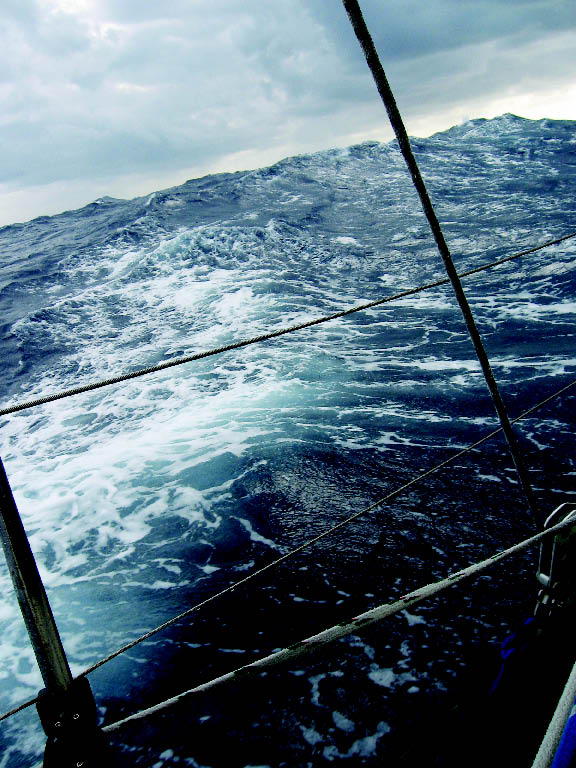
On May 13, I set off from Fort Lauderdale, Florida, bound for Spain, embarking on my 16th Atlantic crossing. I was confident that a pleasant passage loomed ahead. I had assembled a terrific crew, five able mates who had sailed with me on previous ocean voyages. Quetzal, my well-traveled Kaufman 47 cutter was in good order. I had recently replaced the standing rigging and serviced the sails. I had also added a new staysail and two new Harken headsail roller-furling units. Quetzal was well stocked with parts and provisions. The Westerbeke diesel had a few nagging issues, but nothing serious, nothing that we couldn't cope with underway.
I had penciled our route on my well-worn May Pilot Chart of the North Atlantic. We would head north-northeast initially, to take advantage of the favorable north setting Gulf Stream current for a couple of days then angle east toward Bermuda. If things went according to plan we would be toasting ourselves at the Swizzle Inn in less than a week. The next leg, to Horta on the island of Faial in the Azores, was 1,840 miles. My own history suggested and the Pilot Chart confirmed that we'd have fair westerlies most of the way to Horta. The last leg to the continent was typically a reach with fresh northerly and northwest winds, the so-called Portuguese Trades, pouring in over the port beam and quarter. I assured everyone that we'd be in Europe in a month's time.
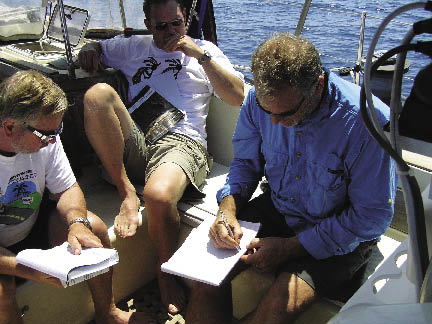
The morning of the second day we encountered a northeast gale in the Gulf Stream. Of course we were heading northeast, and when the wind opposes the current, the Gulf Stream becomes uncomfortable. The seas built rapidly as the winds topped 35 knots consistently with occasional higher gusts. Our progress slowed dramatically. Instead of riding a magic carpet to a couple 200-mile plus days to begin our passage, we tacked east under storm canvas and logged a woeful 88 miles on the second day. Our tactics during this modest gale, to reduce sail and to keep moving by forereaching would later prove invaluable.
We raised Bermuda on the eighth day out of Fort Lauderdale and tied Quetzal to a rickety dock along the St. George's Town quay. One of our discoveries on the first leg was that we had no hot water for showers. This was a minor inconvenience. However, in Bermuda we traced the problem to a faulty heat exchanger. Bob Pingel, a.k.a. SAILING's Boat Doctor, came to our rescue and tracked down a heat exchanger and shipped it out to us ASAP. Doug Sterrett, Chris Roark and Ron Sorenson, all engineers, tackled the job of installing it and we were back on the high seas 48 hours after our first rum swizzle.
The second day out of Bermuda we ran headlong into another northeast gale. A stiff wind was forecasted by the Bermuda Weather Office, however, the gale force winds caught everyone by surprise. The wind increased during the afternoon, leaving us with few good choices. We could either tack due north, well away from our desired heading of east northeast, or continue clawing our way to the east southeast, achieving a better VMG but ultimately taking us below the rhumbline. I chose the latter course, and it proved to be a mistake.
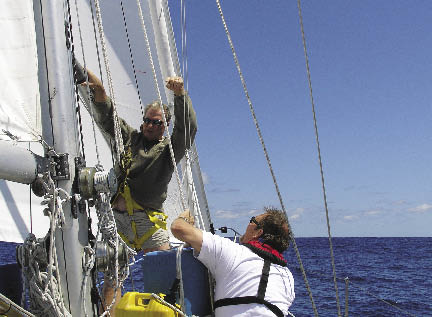
The decision was partly based on Herb Hilgenberg's advice. Herb is the patron saint of Atlantic sailors, and like every other boat crossing the Atlantic last summer we eagerly awaited his afternoon weather broadcasts and routing advice. Herb felt that two deep lows north and south of Bermuda made an east southeast heading the best short-term option. In my gut I knew that we should have been heading north, even if it meant adding miles to the passage. The westerlies tend to more reliable once you get above the 40th parallel, or about 500 miles north of Bermuda.
The gale blew itself out and we were becalmed. No problem, we'd make up for lost time the new-fashioned way, under power. Well, maybe not. The new heat exchanger worked so well that the cooling system couldn't take it, and the engine overheated. We blew a freeze plug in the block, causing us to lose cooling time and again. We eventually fixed the plug with a $2 Canadian coin, a Looney, and some epoxy, but decided to use the engine only in an emergency and for occasional charging.
So we sailed across the Atlantic the old-fashioned way. For a week we battled light, fluky winds. It is interesting how weather reports lose their significance when you can't do much about them. According to Herb there was wind north of us and another gale south of us. Finally, on day nine, the westerlies emerged. We had a couple of days of good sailing and our high spirits returned. My friend Rick Thompson kept the crew entertained with a steady stream of puns. Warren, the senior member of the crew, told quirky stories but had to avoid laughing, even at his own jokes. Early in the passage he fell in the companionway and bruised his ribs. He was in pain most of the crossing.
On the 12th day of leg two, June 1, we had our best run to date, 180 miles. At noon we were just 300 miles from Horta. I had predicted we'd already be there by then but at least we were hopeful that two good sailing days would put us into Horta in time for happy hour at Café Sport, the most famous bar in the Atlantic. Alas, the Atlantic had other plans for us.
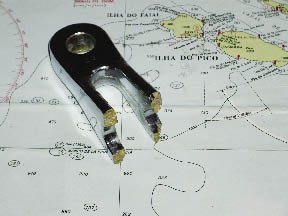
That night the barometer dipped to 1008 millibars, a slight drop and nothing to be alarmed by. A carmine sky greeted us at dawn, and that old saw, red sky by morning sailors take warning, would prove to be the most accurate forecast of the entire passage. By midmorning the winds had backed through the south to the northeast, again. We struggled to maintain the heading to Horta with a single reef in the main and the staysail. By midafternoon the winds were near gale force, steady at 30 knots. It was tough slugging but we were making decent progress, punching through the waves at 5 knots. It looked like we were going to have to earn that drink at Café Sport.
Suddenly there was an explosion. Kabang! I was below and immediately thought the mast had come down. I dashed topsides. "We've lost the staysail stay," Doug shouted. The staysail and the stay were whipping in the wind. Loaded up with furling extrusions, the drum and mounting hardware, it was a deadly battering ram. We tried to furl in the sail but there was no purchase on the line. There was no way to lower the stay.
There was only one thing to do. Ron, Chris and I crawled forward. Doug was at helm and Rick and Warren were manning the sheets. As the stay swung inboard, I lunged at it, and grabbed it for all I was worth. Chris grabbed me as the sail tried to pull away. It must have looked comical as Chris held me and I held the stay. Rick and Warren frantically furled in the sail. Doug steered for all he was worth, running off with just the main. "Don't jibe," I shouted, a ridiculously obvious command. "I'll try," he groaned.
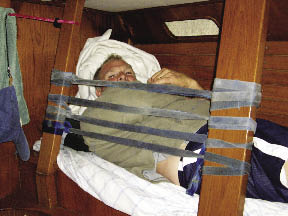
Chris and I managed to lash the stay back in place. Then we tried to lower the sail. Time and again we yanked on the luff but it wouldn't budge. Finally Ron asked if I had the right halyard? I didn't. We eased the staysail halyard instead of the pole topping lift and the sail came right down. Back in the cockpit we examined the cause of the problem, a faulty toggle. The bottom toggle simply pulled apart. From the break it was clear that it was not an installation problem, it had not been under sheer loading, it simply failed in tension. The engineers concluded that it was a bad part. It was also a bad day that was about to get worse.
That night a full gale developed as the low to the north intensified and swooped south. Without the staysail, we were reduced to using a tiny amount of headsail and a deeply reefed main. Fortunately the new Harken Cruising System that we'd installed just before leaving Fort Lauderdale was up to the task as we shortened the headsail all night long. A reluctant dawn crept above the horizon on the morning of June 3. Winds were sustained at 45 knots, Force 9 on the Beaufort Scale. We shortened the watch to two hours, with two men in the cockpit at all times. Quetzal, and I do love her, is sure-footed in a blow but she's wet. The interior was a swamp.
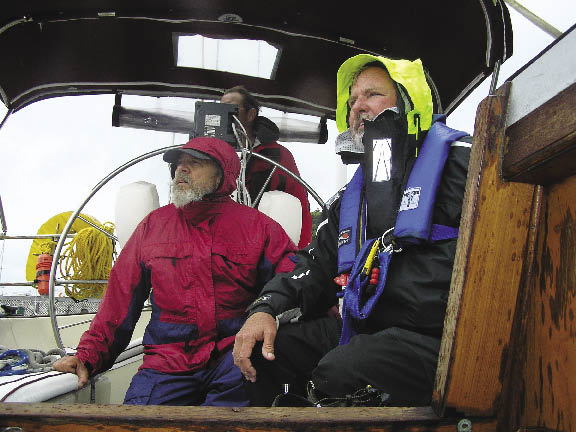
We had a couple of options. We could run off, away from Horta which would immediately ease the motion. We could heave to, although that would be hard to do without the staysail. Or we could press on, slowly forereaching into the teeth of the gale. As you probably guessed, that's what we chose to do. The crew wanted to make landfall in Horta. That night the storm reached its peak, Force 10. (I later confirmed this with weather guru Lee Chesneau.
Doug and Chris had the 2200-to-midnight watch. It was wild and they were both harnessed in the cockpit. Chris was behind the wheel and Doug was trying to maintain his balance on the high side. We had the full cockpit enclosure zipped in place but it was still wet in the cockpit. Lying below, I felt the boat lurch, and then heard Doug shout, "Hold on Chris." A marauding wave washed over the bow and swamped the cockpit. Quetzal was laid over hard to starboard but quickly bounced up.
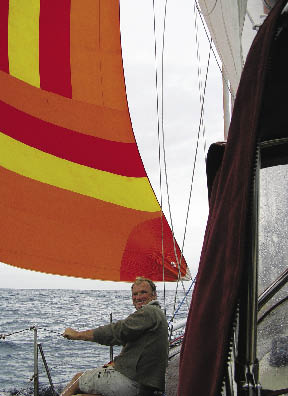
The cockpit had been swamped but the scuppers were quickly emptying the water and other than a blown out panel in the enclosure we were OK. Doug and Chris decided to finish their watch. An hour later Quetzal was crushed by a breaking wave. It sounded like a freight train ran over us. She heeled hard to starboard, over she went on to her beam ends. I was pinned to the side of the berth. Gravity had me, I couldn't move. Finally she came up. I screamed to the crew below, they were stunned but not hurt. Gear had flown all over the cockpit. I charged into the cockpit.
"Are you here, are you guys both here?" I demanded. They were. "We're OK.?Wow, what a wave." The cockpit was a shambles. The spray dodger panels were blown out and the frame was mangled. The enclosure was in pieces. The cockpit seemed terribly exposed. I threw on my gear. Doug took the helm and Chris and I wrestled the dodger frame and canvas below. Rick and Ron shoved it up into the forepeak. Rick and Warren began putting the interior back together and Ron joined us in the cockpit. He and Chris saved the bimini from going overboard with some quick lashes. I crawled forward and surveyed the rig and sails. There was no obvious damage. We'd been knocked down, hard, but we bounced back up and kept sailing. That's what forereaching in storm conditions is all about.
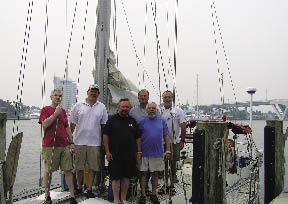
I sent the crew below and began a long stretch at the helm. I was determined to con Quetzal into Horta and didn't want to take the chance of having someone washed overboard in another knockdown. I steered through the night. Another ugly dawn greeted us. We were just 40 miles from Horta, 40 of the toughest miles I have ever sailed. Beating, tacking, pounding, punching, kicking up spray, we pushed Quetzal toward the finish line. Ron and Rick relieved me and I took a much-needed break. By noon we were eight miles away, and by 3:00 we were still four miles out. Cruel hurricane-force blasts cascaded down the mountainsides, pushing us back out to sea. It was time to test the engine. We got it running and Doug and Warren set up a brigade to keep pouring water into the reservoir as we motorsailed toward the south coast of Horta. Finally, around 4:00 we found the lee of the island. Pushing around the stark dome of Porto Pim, we entered Horta Harbor 16 days out of Bermuda.
The scene in the harbor was chaotic. The bad weather had prevented boats from leaving and there were no available slips. Yachts were anchored everywhere, while boats were dragging anchor all over the harbor. It took us three tries to get our big Bruce to set. When it finally took hold, I felt myself relax for the first time in days. Once we were certain that it was holding, we hitched a ride ashore.
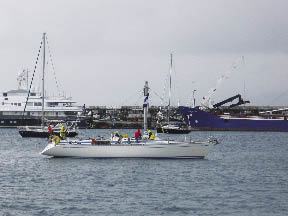
Café Sport was packed, the sea stories were flowing in a variety of languages. An Irish sailor couldn't believe we had just arrived, "You're mad to have come in through this," he cried, and toasted our crew, "to a storm crossing." Indeed. storm-tossed Atlantic leaves John Kretschmer and crew fighting–and forereaching–to make landfall

Comments